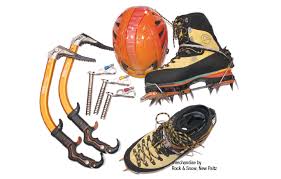Introduction
Are you ready to take your climbing skills to a whole new level of adventure and excitement? If you’re drawn to the icy allure of frozen waterfalls and icy cliffs, ice climbing is the sport for you! Ice climbing is a thrilling and challenging pursuit that allows climbers to ascend frozen terrain, embracing the beauty and challenge of icy heights. But before you embark on your frozen journey, you’ll need the right ice climbing gear to ensure safety and success. In this comprehensive guide, we’ll equip you with the essential ice climbing gear you’ll need to conquer the frozen heights with confidence.
- Winter Clothing – Stay Warm and Dry
When it comes to ice climbing, dressing for the cold is crucial. Layering is key to regulating your body temperature during strenuous ascents. Start with a moisture-wicking base layer to keep sweat away from your skin, followed by an insulating layer to trap body heat. Finish with a waterproof and windproof outer layer to protect against the elements. Don’t forget warm gloves, a hat, and a neck gaiter to keep extremities cozy and protected.
- Ice Climbing Boots – Finding Your Footing on Ice
Ice climbing boots are specially designed to provide insulation and traction on icy surfaces. Look for boots with an insulated lining to keep your feet warm during extended climbs. The soles should be compatible with crampons, allowing for a secure fit to tackle icy terrain.
- Crampons – Your Ice-Biting Talons
Crampons are the essential attachments that fit onto the soles of your ice climbing boots, providing traction on frozen surfaces. There are two types of crampons: step-in and strap-on. Step-in crampons are easier to attach and secure, while strap-on crampons offer more versatility and fit a wider range of boots.
- Ice Climbing Axes – Reaching New Heights
Ice climbing axes, also known as ice tools, are your primary tools for ascending icy terrain. These specialized tools feature curved picks and ergonomic handles to provide maximum control and power while swinging into the ice. Ensure your axes are leashless or have wrist leashes to prevent loss during climbs.
- Climbing Ropes – The Lifeline of Ice Climbers
Ice climbing ropes are essential for safety during climbs and descents. A single, dynamic rope with a diameter of 8.5mm to 9.2mm is commonly used for ice climbing. Ensure your rope is rated for handling the unique challenges of icy conditions.
- Anchor Devices – Securing Your Ascent
Anchor devices for ice climbing include ice screws and ice pitons. Ice screws are drilled directly into the ice and act as anchor points for your ropes and protection. Ice pitons can also be hammered into the ice to provide secure anchors.
- Climbing Helmets – Protecting Your Precious Head
Safety is paramount in ice climbing, where falling ice and debris can pose risks. A climbing helmet is a non-negotiable piece of gear. Choose a helmet that fits comfortably and covers your head adequately to protect against impacts.
- Carabiners – The Versatile Connectors
Carabiners play a vital role in ice climbing, connecting your gear, ropes, and protection. Look for carabiners that are lightweight, durable, and easy to handle, even with gloves on.
- Climbing Harnesses – Supporting Your Ascent
A well-fitted climbing harness is essential for distributing your weight and ensuring safety during ice climbs. Look for harnesses with adjustable leg loops and waist belts for a customized fit. Padded harnesses provide added comfort during long climbs.
- Belay Devices – Controlling Your Climb
Belay devices are crucial for belaying your climbing partner and controlling the rope during ascents and descents. Choose a belay device that works well in icy conditions and provides smooth handling.
Frequently Asked Questions – Your Ice Climbing Gear Queries Answered
- Can I use regular hiking boots for ice climbing?
Regular hiking boots are not suitable for ice climbing, as they lack the insulation and traction needed for icy surfaces. Invest in specialized ice climbing boots for optimal safety and performance.
- What type of gloves are best for ice climbing?
Choose insulated gloves that are designed for ice climbing. Look for gloves that allow for dexterity and have a waterproof and windproof outer layer to protect your hands from the cold and moisture.
- Do I need special ropes for ice climbing?
Yes, dynamic ropes designed for ice climbing are essential. Regular ropes may not hold up well in icy conditions and could be dangerous.
- How do I choose the right ice climbing axe?
When choosing ice climbing axes, consider your climbing style, hand size, and the terrain you’ll be tackling. Test the axes for comfort and feel in your hands to find the ones that suit you best.
Conclusion
Equipped with the essential ice climbing gear, you’re now ready to embark on an unforgettable adventure up icy heights. Remember to prioritize safety, proper training, and preparation before tackling challenging ice climbs. So, bundle up, gear up, and get ready to embrace the frozen beauty of ice climbing, a sport that will undoubtedly take you to new heights of excitement and accomplishment! Happy climbing!
